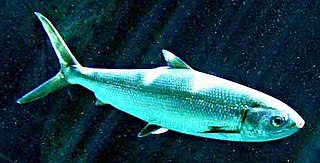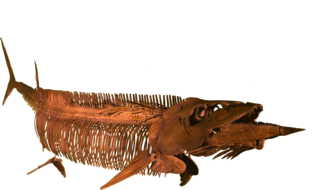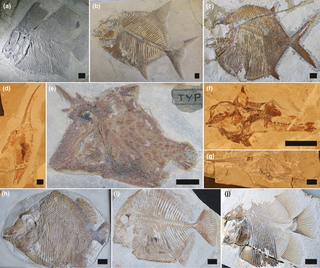
The Gonorynchiformes are an order of ray-finned fish that includes the important food source, the milkfish, and a number of lesser-known types, both marine and freshwater.

Chanidae is a family of fishes which has a number of fossil genera and one monotypic extant genus which contains the milkfish.

Diplomystus is an extinct genus of freshwater and marine clupeomorph fish distantly related to modern-day extant herrings, anchovies, and sardines. It is known from the United States, China, and Lebanon from the Late Cretaceous to the middle Eocene. Many other clupeomorph species from around the world were also formerly placed in the genus, due to it being a former wastebasket taxon. It was among the last surviving members of the formerly-diverse order Ellimmichthyiformes, with only its close relative Guiclupea living for longer.

Gasteroclupea is a genus of prehistoric ellimmichthyiform fish that is distantly related to modern anchovies and herrings. It contains one species, G. branisai. It inhabited freshwater or estuarine habitats across South America during the Campanian and Maastrichtian stages of the Late Cretaceous period, and it briefly survived beyond the K-Pg boundary into the Danian stage of the Paleocene, making it among the few genera from its order to survive into the Cenozoic. Fossils of the genus have been found in the Yacoraite Formation of Argentina, the Chaunaca Formation, Santa Lucía Formation, and El Molino Formation of Bolivia, and the Navay Formation in Venezuela.

Saurodon is an extinct genus of ichthyodectiform ray-finned fish from the Late Cretaceous.

Pycnodontiformes is an extinct order of primarily marine bony fish. The group first appeared during the Late Triassic and disappeared during the Eocene. The group has been found in rock formations in Africa, Asia, Europe, North and South America.

Alisea is an extinct genus of prehistoric marine clupeiform fish that lived in what is now California during the Upper Miocene subepoch. Although generally considered a relative of the herrings in the family Clupeidae, an affinity to shads has also been suggested due to its large size and well-developed abdominal scutes. Its name derives from alise, an alternate spelling for the Hindi name of the related ilish fish.

Coelogaster is an extinct genus of marine ray-finned fish that lived during the early Eocene. It contains a single species, C. leptostea, known from the famous Monte Bolca site of Italy.
This list of fossil fish species is a list of taxa of fish that have been described during the year 2012. The list only includes taxa at the level of genus or species.
This list of fossil fishes described in 2014 is a list of new taxa of placoderms, fossil cartilaginous fishes and bony fishess of every kind that have been described during the year 2014, as well as other significant discoveries and events related to paleontology of fishes that occurred in the year 2014. The list only includes taxa at the level of genus or species.
This list of fossil fishes described in 2013 is a list of new taxa of placoderms, fossil cartilaginous fishes and bony fishess of every kind that have been described during the year 2013. The list only includes taxa at the level of genus or species.
This list of fossil fishes described in 2015 is a list of new taxa of jawless vertebrates, placoderms, acanthodians, fossil cartilaginous fishes, bony fishes and other fishes of every kind that have been described during the year 2015, as well as other significant discoveries and events related to paleontology of fishes that occurred in the year 2015. The list only includes taxa at the level of genus or species.
This list of fossil fishes described in 2016 is a list of new taxa of jawless vertebrates, placoderms, acanthodians, fossil cartilaginous fishes, bony fishes and other fishes of every kind that have been described during the year 2016, as well as other significant discoveries and events related to paleontology of fishes that occurred in the year 2016. The list only includes taxa at the level of genus or species.

Nardorex zorzini is an extinct nektonic predatory aulopiform ray-finned fish from Late Cretaceous Italy.
This list of fossil fishes described in 2017 is a list of new taxa of jawless vertebrates, placoderms, acanthodians, fossil cartilaginous fishes, bony fishes and other fishes of every kind that are scheduled to be described during the year 2017, as well as other significant discoveries and events related to paleontology of fishes that are scheduled to occur in the year 2017. The list only includes taxa at the level of genus or species.
This list of fossil fishes described in 2019 is a list of new taxa of jawless vertebrates, placoderms, acanthodians, fossil cartilaginous fishes, bony fishes, and other fishes of every kind that were described during the year 2019, as well as other significant discoveries and events related to paleoichthyology that occurred in 2019.
This list of fossil fishes described in 2020 is a list of new taxa of jawless vertebrates, placoderms, acanthodians, fossil cartilaginous fishes, bony fishes, and other fishes of every kind that were described during the year 2020, as well as other significant discoveries and events related to paleoichthyology that occurred in 2020.

The Ellimmichthyiformes, also known as double-armored herrings, are an extinct order of ray-finned fish known from the Early Cretaceous to the Oligocene. They were the sister group to the extant true herrings, shad and anchovies in the order Clupeiformes, with both orders belonging to the suborder Clupeomorpha.









